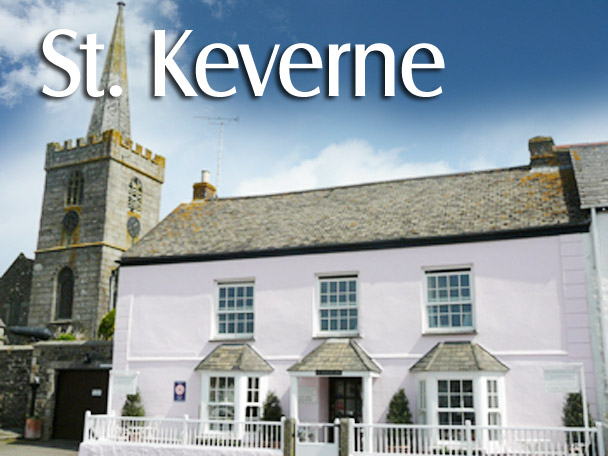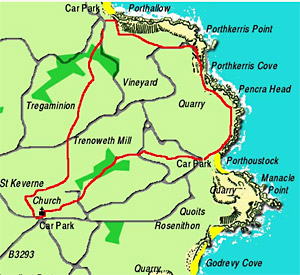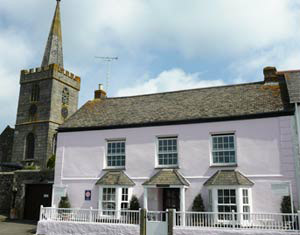St. Keverne- West Cornwall - Lizard Peninsula

 |
|
|
St. Keverne village square and St. Keverne Church and The Old Temperance House B&B |
|
St. Keverne
West Cornwall - Lizard Peninsula
St. Keverne village, one mile inland from the coastal path, clusters around the central square; you'll find whitewashed cottages, two pubs and a handful of shops, all overlooked by the 15th century church of St. Akervnus.
On summer evenings you might catch the St. Keverne Band, or the Male Voice Choir, and the square really comes alive at the annual festivals of the Ox Roast, Carnival and Rodeo. A short walk out of the village brings you to Tregellast Barton, where you can follow lakeside and woodland nature trails.
Two Cornish rebellions, one in 1497, the other in 1547, have their roots in St. Keverne In the church wall, facing the square, there's a memorial stone to the village blacksmith Michael Joseph, co-leader of the first uprising.
Protesting against the punitive taxes levied by Henry VIII, Michael Joseph (An Gof), a blacksmith from St. Keverne and Thomas Flamank a lawyer of Bodmin, led the people of Cornwall into armed revolt against the King. The uprising ended in Surrey at The Battle of Deptford Bridge (also known as Battle of Blackheath) on 17 June 1497. Joseph and Flamank were both sentenced to a traitor's death and executed at Tyburn on 27 June 1497 - where they benefited from the king's mercy by being allowed to hang until dead before being drawn and quartered.
St. Keverne was the site of an important monastery during the Middle Ages. The church is very large for a village church and the tower is topped by a distinctive octagonal spire (unusual in Cornwall), which was probably added as a daymark for ships as they sailed past the treacherous “Manacles” (meaning Church Rocks from the Cornish" Maen Eglos"), a submerged reef just over a mile offshore and scene of many wrecks. Nowadays, The Manacles is a favourite diving site with a wealth of marine life living rocky seabed and remains of many wrecks.
In St. Keverne Church there's a shipwreck window; and in the churchyard,there is a stark memorial to the 106 lives lost when the liner Mohegan was wrecked in 1898 -just off the coast at Porthoustock (pronounced 'P'rowstock') on the Manacles - jagged rocks lying beneath the surface of the water.
Also in St. Keverne Churchyard, adjacent to the lych-gate, there is a 32-pounder carronade. It was recovered by divers in 1978, from the wreck of HMS Primose - also wrecked on the Manacles reef (21 January 1809) with the loss of 125 lives and only one survivor, a drummer boy.
The village itself was once the haunt of smugglers. In 1762, five men from here brought home 218 barrels of brandy!
A few boats still set sail from the pretty fishing village of Porthallow, where, in 1832 1,400 hogsheads of pilchards were landed in one day . Stroll along the beach for spectacular views of Falmouth Bay, then browse through the collection of shipwreck relics and old photographs in the pub.
 |
|
|
Late Vacancies & Special Offers |
 |
|
Promoting
your business on Cornwall Online |
|
Cornwall
Online is a trading name of ITS WEB DESIGN - COL DIRECT
Cornwall Online Website by ITS WEB DESIGN - COL DIRECT. Tel 01579 557343 Please ensure that you confirm all details with the Advertiser before Booking We recommend that you take out Holiday Insurance on ALL Bookings |



